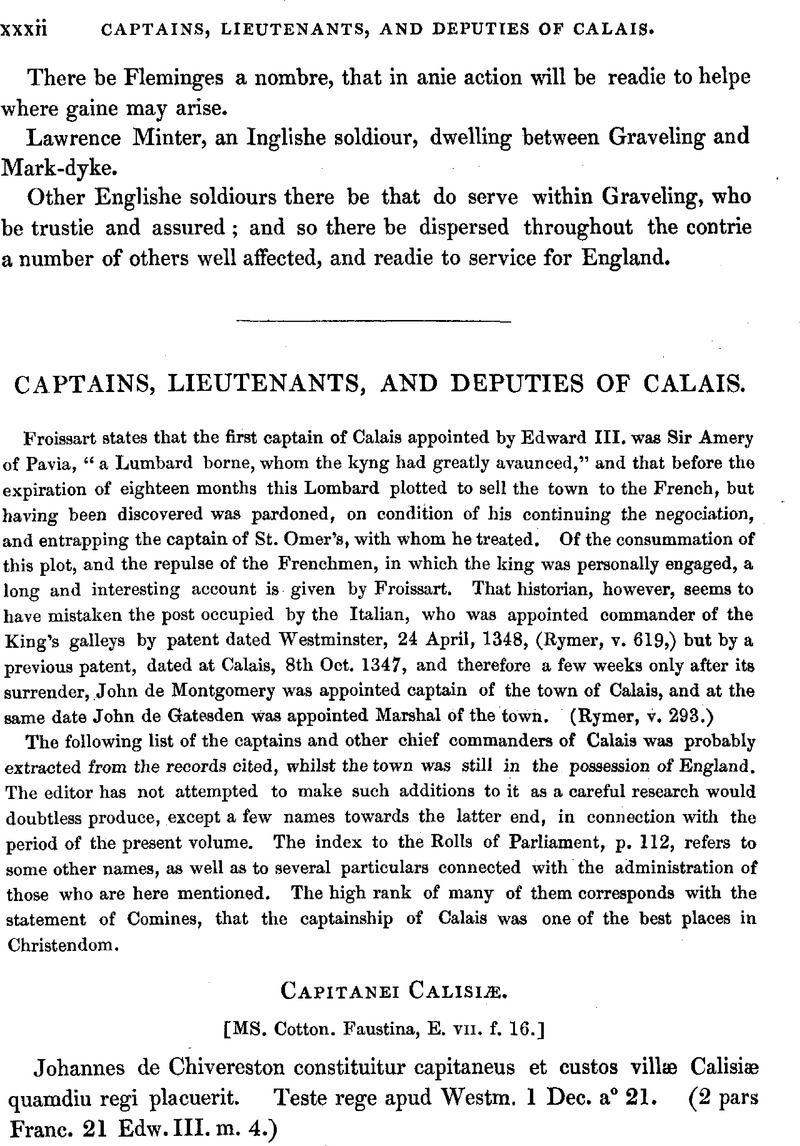No CrossRef data available.
Article contents
Captains, Lieutenants, and Deputies of Calais
Published online by Cambridge University Press: 23 February 2010
Abstract

- Type
- Other
- Information
- Camden Old Series , Volume 35: Chronicle of Calais, in the Reigns of Henry VII. and Henry VIII. to the Year 1540 , December 1845 , pp. xxxii - xlii
- Copyright
- Copyright © Royal Historical Society 1845
References
page xxxvi note * Dugdale (Baronage, i. 244) has quoted an indenture, dated 19th June, 1415, by which the earl of Warwick was retained to serve as captain of Calais until the 3d Feb. following. An account of the garrisons kept at this period at Calais, Risebanke, Guysnes, and Hammes, is printed in Excerpta Historica, 8vo. 1831, p. 25.
page xxxviii note * Giles lord Daubeney was fined in the Starchamber 200l. for his pardon for receipts of money at Calais. Archæologia, vol. xxv. p. 392.
page xxxviii note † These three deputies are named, with John Lord Berners, in the patent constituting lord Lisle.
page xxxviii note ‡ The patent for the appointment of lord Lisle is printed in Rymer, vol. xiv. p. 452. It describes the office conferred as “deputatiam nostram sive officium deputatiæ nostræ villæ nostræ Calisiæ et marchiarum ibidem.” He was to receive in support of his office an annual rent of 100l. sterling, payable from the royal lordships or manors of Marc and Oye ; also an annual sum of 104l. sterling for “spyall money,” to be received from the same manors ; he was allowed a retinue of thirty-one “souidiours,” namely, one horseman called “a spere,” two horsemen called “archers,” and twenty-eight others called “souldeours ; “ also, because no other lieutenant of the town and marches was appointed, a further retinue of ten “souldeours.” By the two next clauses the election and removal of the said souldeours was granted to him ; and by the following the power of granting safe conducts to aliens, and certain other privileges necessary to the due administration of his government.
page xxxviii note § Lord Cobham was deputy of Calais for a period extending from 1544 to 1550, (as appears from his papers,) but I have not found the date of his appointment.
page xxxix note * Lord Wentworth was the deputy at the time of the loss of Calais in 1558. Sir John Hayward (Hist, of Edward VI. p. 162,) states that lord Grey of Wilton was made deputy of Calais, and that statement is adopted by Dugdale (Baronage, i. 715). But lord Grey was only captain of Guisnes when Calais was taken, and his subsequent defence of the former fortress is described by his son, in a paper which was used by Holinshed, and which is about to be printed by the Camden Society, from the original in the possession of Sir Philip Grey Egerton, Bart.
page xxxix note † Rymer, xiii. 298.
page xxxix note ‡ In MS. Cotton. Vesp. F. xiii. p. 78, is a royal warrant, dated Greenwich, March 12, 1511, to sir Hugh Conway, treasurer of Calais, to pay 200l. to Thomas Deacon, to be expended in the repairs of Rysebank.
page xxxix note § He held this office of “under marshall” in 1508 (see p. 6).
page xl note * In Nash's History of Worcestershire, vol. i. p. 85, where a pedigree of the family of Nanfant or Nanfan will be found, sir Rich. Nanfan is styled “captain of Calais “ (i. 85), and in the next page “treasurer of Calais, and deputy lieutenant of the castle,” in 18 Hen. VII. 1503 ; but this is only Dr. Nash's want of precision ; and Cavendish was probably right in the office, though not in the Christian name.
page xli note * Possibly this word maybe a misprint for “souldeours.”




